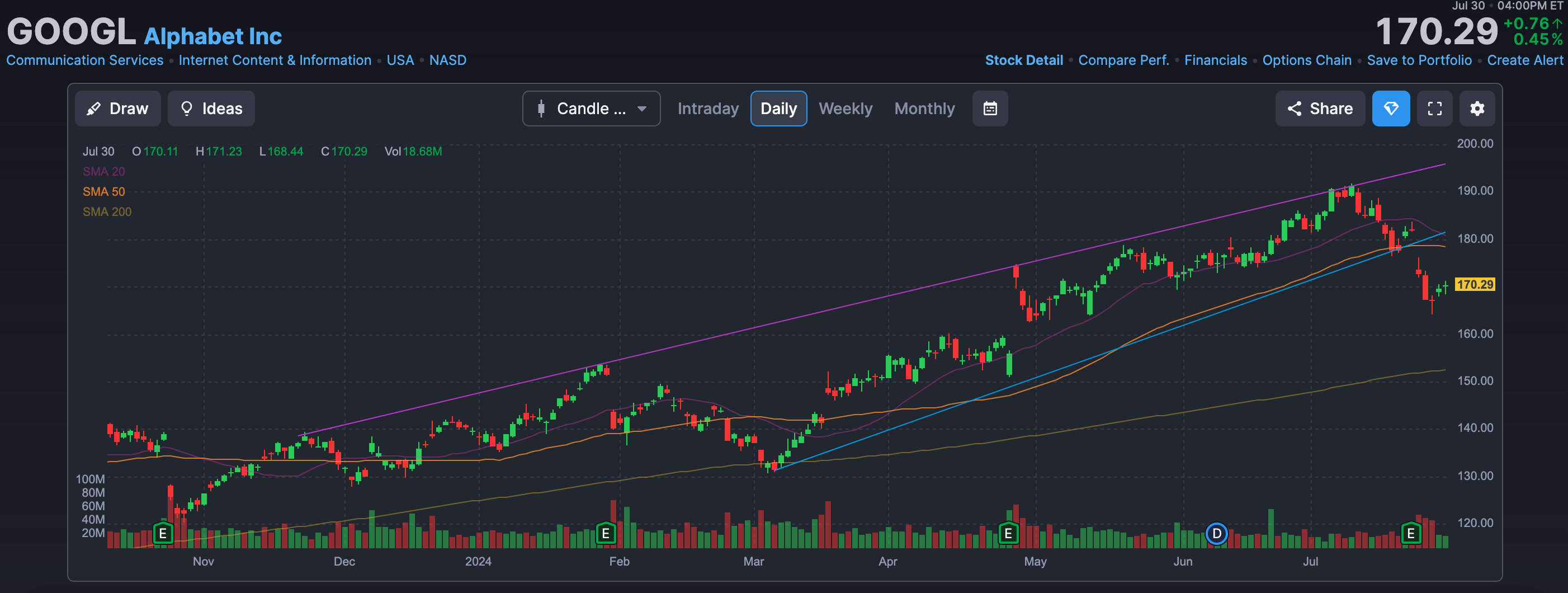
Introduction
Alphabet Inc., the parent company of Google, is a major player in the tech industry, offering an appealing option for investors. The evaluation of whether to invest in a stock or not is crucial when considering any stock, including GOOGL. This process involves analyzing various financial metrics and market conditions to determine if it aligns with your investment goals.
Key takeaway: GOOGL stock presents both strengths and weaknesses that you should weigh carefully. By understanding these aspects, you can make a more informed decision about whether Alphabet Inc. fits within your portfolio strategy.
As always, text in green is a link to additional information that you might find interesting as you read this post.
Current Financial Performance
Looking at Alphabet Inc.’s Q2 financial results gives us a clear picture of where the company stands right now. The numbers show both successes and areas that need improvement.
Summary of Q2 Financial Results
Alphabet’s Q2 results revealed a robust 14% revenue growth, pushing total revenue to $84.74 billion. This figure indicates a healthy upward trajectory compared to previous quarters, reflecting the company’s ability to generate substantial income.
Earnings: $1.89 a share vs. $1.84 per share expected
Revenue: $84.74 billion vs. $84.19 billion expected
Here are other numbers Wall Street was watching:
- YouTube advertising revenue: $8.66 billion vs. $8.93 billion, according to StreetAccount
- Google Cloud revenue: $10.35 billion vs. $10.20 billion, according to StreetAccount
- Traffic acquisition costs (TAC): $13.39 billion vs. $13.54 billion, according to StreetAccount
Alphabet’s revenue was up 14% year over year, driven by search as well as cloud, which surpassed $10 billion in quarterly revenues and $1 billion in operating profit for the first time.
Dividend Prospects
Although Alphabet does not currently pay dividends, substantial net income could pave the way for potential future dividend payments or share buybacks.
These highlights from the Q2 financial report demonstrate Alphabet’s strong financial health. The revenue growth and significant net income reflect positively on its current performance while providing a foundation for future prospects.
Now, let’s look at the business lines that generate the revenue.
Advertising Revenue Insights
Advertising revenue remains a crucial component of Alphabet’s financial performance. In the recent quarter, Alphabet reported an impressive $64.62 billion in advertising revenue. This marks a significant portion of the company’s overall income and highlights its dominance in the digital advertising space.
When compared to the same quarter last year, this represents a growth of 12%. Last year, Alphabet’s advertising revenue stood at $58.14 billion, indicating robust growth and resilience in an increasingly competitive market. This increase can be attributed to several factors, including higher ad spend across sectors and improved ad targeting technologies.
YouTube’s Performance
YouTube has been a standout performer within Alphabet’s portfolio. The platform continues to draw in substantial ad dollars, contributing significantly to the overall advertising revenue.
According to third-party analyses, YouTube’s ad revenue is estimated to be around $8.66 billion for the recent quarter, reflecting a year-over-year growth rate of approximately 13%. This underscores YouTube’s vital role in bolstering Alphabet’s financial health amidst fluctuating market trends.
Cloud Segment Performance
Google Cloud reported quarterly earnings of $10.35 billion, a significant figure but one that fell short of analyst expectations. This discrepancy between projected and actual revenue raises concerns about the sustainability of the segment’s growth. Analysts had anticipated higher returns, making the shortfall noteworthy for investors.
Compared to last year’s quarterly revenue of $9 billion, the current earnings represent a year-over-year growth of approximately 13%. Despite this growth, the failure to meet analysts’ expectations tempers the optimism surrounding Google Cloud’s performance.
Ultimately, Google Cloud will be a winner, and analyst expectations were likely overly optimistic. The $10.35 billion in revenue represents a record for the company and that will likely continue.
Impact of AI on Google Search Revenue and Future
The rise of artificial intelligence platforms like ChatGPT presents both opportunities and challenges for Google’s traditional search business. AI-driven sites are increasingly capable of providing users with direct answers, reducing the need for traditional search queries that drive ad revenue for Google.
As users turn to these AI solutions for quick, conversational responses, there is potential for a decrease in search traffic, which could impact Google’s primary revenue stream from search advertising. Additionally, since the AI provides a summary of the information, users are not clicking through to the actual websites themselves, impact the content creators in a negative manner as well.
Google’s Strategic Response to Maintain Traditional Search Relevance
To counteract the potential decline in search revenue due to AI advancements, Google is implementing several strategies:
- Integrating AI into Search: Google is enhancing its own search engine with advanced AI capabilities to provide more accurate and contextually relevant results. By incorporating features similar to conversational AI, Google aims to retain users within its ecosystem. Sundar Pichai, CEO of Alphabet Inc., stated during the most recent conference call, “We believe our investments in AI will enhance our search experience and ensure we continue to deliver value to our users.”
- Diversifying Revenue Streams: Recognizing the potential threat from standalone AI platforms, Google continues to expand its revenue sources beyond traditional search. Investments in YouTube, cloud services, and other non-search ventures aim to mitigate dependency on search advertising revenue. Ruth Porat, CFO of Alphabet Inc., mentioned, “Our focus remains on diversifying our business model to ensure sustainable growth across all segments.”
- Improving Ad Targeting: Leveraging its vast user data repository, Google is focusing on improving ad targeting precision. Enhanced targeting can drive better ad performance and higher return on investment for advertisers, making Google’s ad platform more attractive despite shifts in user behavior. Pichai added, “We’ve made significant advancements in machine learning that enhance our advertising solutions and improve targeting accuracy.”
- Developing Exclusive Content and Services: To keep users engaged within the Google ecosystem, the company is investing in exclusive content and premium services across its platforms. This strategy includes bolstering YouTube’s content offerings and expanding cloud services to businesses. Pichai emphasized, “Our commitment to innovation in content creation and service delivery will keep us ahead of the curve.”
By proactively adapting to the evolving digital landscape and integrating cutting-edge technologies into its core offerings, Google aims to sustain its dominance in search while exploring new growth avenues to secure its long-term financial health.
Market Reactions and Stock Performance
Stock Market Reaction Post-Q2 Report
After Alphabet Inc. released its Q2 financial results, the stock market reacted promptly. In after-hours trading, the share price dropped by 5%. This decline reflects investor sentiment reacting to the mixed results presented in the earnings report. Since the report, it is down about 10% as you can see in the graph below.
Pros and Cons of Investing in Alphabet Stock Today
Pros of Investing in Alphabet Stock Today
1. Alphabet’s Strong Brand Reputation
Alphabet Inc. has a strong brand presence that makes it a leader in the tech industry. Google’s dominance in search engines, Android’s widespread use, and YouTube’s large user base give it an advantage over competitors. This strong brand reputation not only attracts consumers but also builds trust among investors.
2. Potential Benefits from AI Integration
Integrating generative AI technologies into Alphabet’s products and services holds immense potential for future growth. Google’s advancements in AI, such as its contributions to natural language processing and machine learning, enhance product offerings and operational efficiency. AI-driven innovations can lead to new revenue streams and cost savings, positioning Alphabet favorably for long-term prospects.
3. Wide Moat
Alphabet enjoys a wide economic moat due to its diversified portfolio of leading products and services, extensive data assets, and robust technological infrastructure. This strong competitive advantage allows the company to maintain market leadership and fend off competitors effectively, ensuring sustained profitability and long-term growth opportunities.
Cons of Investing in Alphabet Stock Today
1. Risks Associated with Underperformance in Cloud Services
Despite significant investments, Google Cloud Services missed analyst expectations. I do not know what those estimates were based upon, but it bears watching. Most likely, the analysts were simply too aggressive, but if missing estimates continues or if other cloud providers miss estimates it could be a sign that the growth of cloud services is slowing which will impact the entire industry.
2. Competitive Landscape Within the Tech Industry
The tech sector is highly competitive, with major players like Amazon, Microsoft, and Apple continuously innovating. The intense competition can affect Alphabet’s market share and profitability. Fortunately, the wide moat protects its most critical revenue streams.
Expected Return Calculation for GOOGL Stock Investment Analysis
To determine if investing in GOOGL shares fit your financial goals, important to calculate projected returns before committing your capital. Based upon the Capital Asset Pricing Model calculation the projected 5yr return is 22.98% using the 60-month beta, the Yachtman Forward Rate of Return, and the current T-Bill Rate.
The Capital Asset Pricing Model (CAPM) is a fundamental financial theory used to evaluate the expected return on an investment by correlating it with the risk of the asset in comparison to the market.
One of its key strengths lies in its simplicity and ease of use, allowing investors to estimate returns based on systematic risk, or beta, relative to the overall market. This makes it a valuable tool for portfolio management and capital budgeting decisions.
However, CAPM also has notable weaknesses. It operates under several assumptions such as markets being efficient and investors having homogenous expectations, which may not hold true in real-world scenarios. Additionally, CAPM considers only systematic risk and ignores other forms of risk that might affect an asset’s returns.
In terms of accuracy, while CAPM provides a theoretical framework for understanding risk-return trade-offs, its predictive power can be limited due to its reliance on historical data and assumptions about market behavior. As a result, while useful, it should be applied with caution and supplemented with other models and analyses to gain a comprehensive view of expected returns.
Over the years, I’ve adapted the traditional formula to use specific data not anticipated by Efficient Market Theory. The 22.98% shown above is based upon my adaptation that I have found is more accurate – but still an estimate that could be heavily impacted by real world events. As such, this is just one piece of the puzzle in determining if the stock is suitable for purchase.
Valuation
Everyone knows the phrase “buy low and sell high” as a way to ensure you make money on your investment. Projected returns for a company mean that the price you buy a stock is just as important as the price that you sell it. When you buy a stock, in order to “buy low” you have to know the value of what you are buying compared to what its real value is. To determine this, I use a discounted cash flow analysis to determine the fair value of the stock based upon its projected cash flows.
The discounted cash flow (DCF) analysis suggests a fair value of $182 per share. Presently, the stock trades at $170 per share, indicating that the market price is below the calculated fair value. This discrepancy highlights a potential slight undervaluation, suggesting that there may be an opportunity for investors to purchase shares at a price la bit lower than their fair value.
When considering the DCF fair value, it is important to recognize that this valuation method accounts for the company’s estimated future cash flows, discounted back to their present value. The fact that GOOGL is trading below its DCF fair value could imply that the market has not fully priced in the company’s future earnings potential and cash flow generation capabilities.
Investors should take this information into account alongside other financial metrics and qualitative factors when making an investment decision. While the current trading price offers a slight margin of safety toward a profit, you have to decide if either here is enough profit to entice you to buy it or there is a strong chance that the cash flow estimates are conservative and fair value is actually higher.
Analysis of Technical Indicators
Technical indicators are tools for investors to analyze market trends and make informed decisions. These indicators help in understanding market sentiment, potential price movements, and the overall strength of a stock.
Relative Strength Index (RSI)
- Current Value: 57
- Interpretation: RSI is an intermediate-term indicator and is currently in the neutral range. The stock is neither overbought nor oversold, indicating stable market sentiment.
Moving Average Convergence Divergence (MACD)
- MACD Line: 1.23
- Signal Line: 1.05
- Histogram: Positive
- Interpretation: The MACD is a longer-term indicator. The positive histogram and the MACD line being above the signal line suggest a bullish trend, indicating potential upward momentum.
Stochastic Oscillator
- %K Line: 80
- %D Line: 75
- Interpretation: The stochastic oscillator is a near-term indicator it is approaching overbought territory. This could indicate an upcoming price correction within the continuation of the current uptrend, depending on other market conditions.
Based on the near-term stochastics indicator closing in on over-bought territory, but with the stock in an uptrend, I believe a slightly better stock price could be had once the near-term overbought condition resolves itself. These overbought conditions resolve themselves in two ways, with a price pullback or a rangebound price for a period of time before the longer-term trend reasserts itself.
Should I Buy This Stock
Given the information provided, let’s analyze whether Alphabet Inc. (GOOGL) is a good candidate to add to an investment portfolio.
Reasons to Consider Buying
- Strong Financial Performance: Alphabet has demonstrated robust financial health with a 14% revenue growth in Q2 and a net income of $23.6 billion. This strong performance indicates effective business strategies and market demand.
- Dominance in Advertising: With significant revenue from advertising, including $64.62 billion this quarter, Alphabet remains a leader in digital advertising, showcasing its ability to capitalize on ad spending trends.
- Growth Potential in Cloud Services: Although Google Cloud slightly missed analyst expectations, it still reported $10.35 billion in earnings, indicating substantial growth potential.
- Innovation and AI Integration: Alphabet’s continuous innovation and integration of AI into its services promise future growth avenues, enhancing product offerings and operational efficiency.
- YouTube’s Strong Performance: YouTube continues to be a major revenue driver with an estimated $8.66 billion in ad revenue for the quarter.
Reasons to Consider Not Buying
- Underperformance Concerns: The shortfall in Google Cloud earnings compared to analyst expectations raises concerns about its growth trajectory.
- Competitive Landscape: The tech industry is highly competitive with major players like Amazon, Microsoft, and Apple posing significant challenges to growth areas, like AI.
- Regulatory Scrutiny: Ongoing regulatory scrutiny could impact Alphabet’s operations and profitability.
- Market Reaction Volatility: The 5% drop in stock price post-Q2 results highlights market sensitivity to mixed financial outcomes.
Conclusion
After thorough analysis, it appears that the reasons to buy outweigh those to not buy.
- Despite certain underperformance areas, the company’s overall robust financial health and dominant position in key markets present strong investment opportunities.
- The potential upsides from AI integration and sustained advertising revenue growth further bolster its appeal as a long-term investment.
Based upon this analysis, we believe that a professional investor would consider buying this stock at this time based upon the fundamental analysis and current valuation, but likely conclude they should wait until the technical indicators turn more favorable.
Be sure to do your own due diligence before you buy or sell a stock. It is your responsibility to thoroughly research any investment and decide what is right for you. This opinion is solely for education purposes and not investment advice you should act upon.
Understand that even if we believe a professional investor would consider this stock a buy or a sell, many intangible factors can influence the investment decision beyond the company’s fundamentals and we have no way of knowing your specific financial situation, risk tolerance, nor investment objectives.
If, however, you would like to discuss opening an investment account with us, contact Karen Sharp at (217) 351-2870 or [email protected] to discuss how we can help you.
Thanks for reading,
Mark
PS – after I wrote this, Microsoft announced their quarterly earnings and their cloud services also missed revenue expectations.


